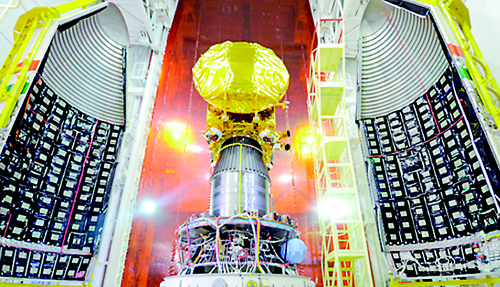Sunday Times 2
India’s Mars mission cue for third world
[NEW DELHI] India’s successful Mars Orbiter Mission holds out possibilities for its neighbours in South Asia to enter the rarefied world of space science.

Image credit: Indian Space Research Organisation
On Wednesday, when the Indian Space Research Organisation (ISRO)’s spacecraft, Mangalayaan, entered Martian orbit, it made India the only country to achieve the feat on a first attempt – and that at a cheap US$ 71 million.
In comparison, the US NASA’s Mars Atmosphere and Volatile Evolution (MAVEN) craft, which entered Mars orbit three days earlier, cost US$ 671 million.
“The Mars mission has shown the world what we can achieve with limited resources and limited time. This can be a source of confidence for South Asian and other developing countries,” says U.R. Rao, former ISRO chairman.
Rao tells SciDev.Net that ISRO is now seriously considering a proposal announced earlier by Prime Minister Narendra Modi to put together a satellite for the eight-nation regional bloc, the South Asian Association for Regional Cooperation (SAARC).
Already, the Indian Institute of Remote Sensing, Dehradun, helps other countries develop capacity in remote sensing and geographical information system (GIS) applications.
India’s 2008 ‘Chandrayaan’ moon mission carried payloads for 20 different countries and earned the International Lunar Exploration Working Group’s International Cooperation Award. Rao is hopeful that cooperation to develop a SAARC satellite will encourage India’s neighbours to develop scientific capabilities not only indata interpretation but also in scientific research.
According to its director Koppillil Radhakrishnan, ISRO saved on costs through techniques such as raising the spacecraft to a higher earth orbit using a fuel-saving propulsion system rather than a heavy launch vehicle. The payload was also limited to a low 16 kilogrammes.
ISRO successfully used the ‘Hohmann transfer orbit’, a window that opens every two years allowing fast approach to Mars, thus saving time and fuel.
Mangalayaan’s success stands against the failure of China’s Yinghuo 1 spacecraft to Mars which its state media reported as lost in November 2011 following rocket failure.
China will now have to wait till 2015 for a second go at Mars to take advantage of the Hohmann transfer orbit.
ISRO saved on costs in other ways. Mangalayaan’s sub-systems are similar to those used by other spacecraft and, unlike NASA, there was minimal dependence on contractors. “The scale of engagement of industry is much lower than in the case of the US and other developed countries,” says Rao.
Technologies sourced from local industry were also cheaper. “Technologies like that used on the cryogenic engine and communication systems were produced by indigenous companies working with ISRO, but developed at a fraction of the cost charged by US companies,” says Rao.
Rao and other scientists also attribute lower costs to the dedication of Indian scientists who worked overtime at comparatively low salaries to get Mangalayaan going.
“I am familiar with several of the hard-working dedicated scientists and engineers involved in making Mangalayaan a success,” says Carle Pieters, faculty at the department of earth, environment, and planetary sciences, Brown University, Providence. ”
India has shown itself to be a full participant in improving global scientific knowledge on space sciences and can emerge as a leader in the region.”
Like MAVEN and other Mars missions, Mangalayaan will look for traces of methane, a tell-tale sign of life. “While other Mars missions have looked for the presence of methane in specific areas, Mangalayaan will look for methane on the entire planet,” says S. Satish, former communications director for ISRO.
“All this shows the way for developing countries to participate in developing low-cost space missions,” Satish tells SciDev.Net.
Significantly, seeing the success of Mangalayaan, both the US and China have proposed collaborative work on space technology with India.
(Courtesy SciDev.net)

